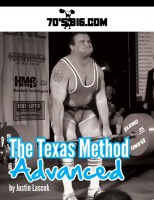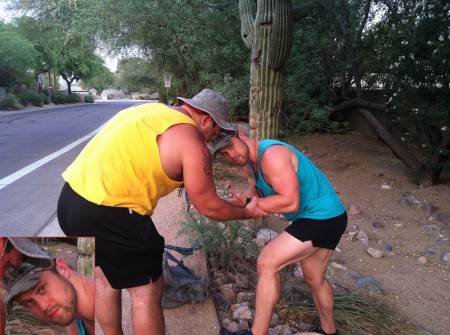Quick post today due to travelling.
NolanPower
70’s Big reader Nolan Power has gone to Sweden for the first ever IPF Raw World Championships. He decided to cut down to the 93kg class (the weight classes are different nowadays in the IPF). You can read his post about his planned attempts HERE; it’s part of his training log. The stream for the meet is in the post, and he lifts some time on Friday. Good luck, Matt.
Criley
I just learned this morning that Chris is now considered the first place winner in the 120+ weight class from the 2012 NAPF Raw Challenge that occurred at The Arnold Sports Festival in March. This means that he won his first international IPF meet, and it also means he is the North American Champion! The guy who won the weight class tested positive for some kind of PED, so he was disqualified.
To celebrate, here is a video of how Chris trains bench press:
In case you missed them in the Facebook/Twitter feeds, here are some videos of Mike and Chris training recently. Mike squats 530×3 pretty easily and then reverse band deadlifts 615×6; Chris rack pulls up to 675×3 about a month and a half after injuring his lower back. Oh, and this video was part of Chris’ “rehab” of working back into things; I’m linking it cause Mike says something funny at the end.
If you’re still hankering for more vids, then review the “hip torque” concept:
The Texas Method: Advanced
The wait is finally over…
The Texas Method: Advanced
You’ve been on the Texas Method for a while, and you’ve even implemented some of the changes from The Texas Method: Part 1, but progress is starting to slow. After all, no program will work forever. Do not fret, for over the last several years we have been learning and tweaking this program into an amazingly efficient machine that has yielded a 661 competition squat, a 705 competition deadlift, 402 competition bench press, and a 275×3 standing press.
The Texas Method: Advanced teaches you how to control dosages of volume, how to structure the program for use in raw powerlifting, and a variety of important programmatic tweaks like “Intensity Day Rotations” and a new template that will push you past your sticking points. There’s 90 pages of information, and most of it can be pulled and used in almost any program. This is the most proven and effective programming tool 70’s Big has created to date. And did I mention that the forward is written by Brent Kim? Now you know it’s good.


Table of Contents
FORWARD From Brent Kim 04
CHAPTER 1 Relativity of Volume 06
CHAPTER 2 Using the TM for Powerlifting 10
CHAPTER 3 Modifying the Texas Method 26
CHAPTER 4 Advanced TM Modifications 51
CHAPTER 5 And Beyond… 68
ABOUT THE AUTHOR, CONTACT, AND PRODUCTS 88
REFERENCES 90
Experiment for da ladies
Some females that lift still have weaknesses in their shoulder girdle or upper back despite the fact that they have lifted for at least one year. This is more common when the female is taller or has longer limbs because they won’t have large amounts of muscle mass to improve the angle of muscle attachment (this concept was discussed in this post — more on the same topic). Doing presses and rows are good at developing this musculature, but some times a specific deficiency needs specific work.
Band pulls are typically used in powerlifting programs to strengthen the shoulder girdle. Many powerlifters and their coaches despise overhead because it’s labeled as “injurious”. We know that by pressing correctly in external rotation and achieving a good overhead position is not injurious and is exceptional at increasing the strength and stability in the shoulder girdle. My hypothesis is that assistance work like band pulls were created to help keep shoulders healthy because there was an absence in quality overhead work. They were also developed in the realm of physical therapy to address muscle imbalances, which would be the case in a guy/girl who has a weak upper back.
Here’s the experiment: throw them in at the end of your training on a daily basis for at least a month. If “daily” won’t work, then do them at least three times a week. They can be done on the weekend, and could probably be done the day before a lifting session (though I’d avoid it before the heaviest session). Let’s see if there’s a significant improvement in pull-up strength, overhead strength, or the ability to stay in external rotation on the bench or press (elbows staying in and under the wrists). Guys, if you have issues with flaring elbows or a weak upper back, then do this experiment. They will only help the shoulder and won’t cause any harm. Remember that most of these “female topics” also apply to guys.
The video below explains how to do them. Cliff notes:
– use a light band
– use a supinated (underhand grip) that is at or right outside of shoulder width
– horizontally abduct shoulders (reverse fly)
– keep elbows/wrists straight
– control out and in (don’t flop back in)
– use 3 sets of 10 to 15 reps
– wear cool sunglasses
70’s Big Workshop – Washington, DC – June 23/24
What: 70’s Big Workshop Weekend
When: June 23 and 24
Cost: $175 for one day, $300 for both
Info and Payment Page
Q&A – 29
PR Friday
Please post your training PR’s and updates to the comments. Remember, it’s the best way to integrate yourself in this incredible community. Oh, and I’m more likely to help you or answer your question(s) if you post regularly; fuckin’ oath.
Last Week’s Challenge was to do at least two days of heavy farmer’s walks at the end of your training session. Did anyone hit this challenge up? Post your weight and estimated distance.
Next Week’s Challenge: Given this week’s article on conditioning, the challenge is to add in a day or two of conditioning into your program. Don’t over-complicate it, and no I’m not turning you into a CrossFitter. How intense the conditioning should be is dependent on what you’re adapted to. Just drop some sled drags/pulls in, do some kettlebell work, or try one of those fancy barbell complexes. If you hate it, well, shit, it’s only one week of it.
Weekly Recap
On Monday I recapped some of the Tucson, AZ seminar, but also traveled all friggin’ day (never good for mobility). Tuesday made the point that even strength athletes will benefit from conditioning, and unless it’s misused, it won’t interfere with strength training. Wednesday discussed training efficiency and urged readers to ensure that they were getting the most of their time spent training and recovery. Thursday started as a rant because of something corny I saw on Facebook (it was a picture of a self assurance fortune cookie that said, “You are wonderful,”) — it developed into having a mindset that always aims to improve, but then focused on being able to instill that in trainees/clientele as a coach or trainer.
There are tons of pictures from last week, but the most poignant lesson I learned is: “Don’t mistake a cactus for a tree.” In my defense, there are no cacti where I’m from. I leaned against one to step off of a trail, and ended up with at least 15 spines in my hand. Here’s a picture that encapsulates some pain and embarrassment.
In other news, there will be a surprise for many of you on Tuesday.
Q&A
CONTINUE READING Continue reading


